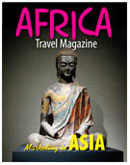|
African Tourism
Marketers Take Notice
Korea Now a
Tourism 'Superpower'
The
number of Koreans travelling abroad passed the 10 million
mark for the first time in 2005, growing at a rate of 14.2%
for the year. The upturn helped drive arrivals figures to
new heights in popular Korean destinations such as China
(PRC), Japan and the USA.
The
outbound surge was particularly strong in the Korean summer
with more than one million Koreans travelling abroad in both
July and August, the country's peak outbound
season.
The 2005
statistics just released from the Pacific Asia Travel
Association (PATA) and the Korea Tourism Organization show
that:-
* The
most popular destination regions were Asia (72.6%), the
Americas (8.1%), Europe (5.8%), and the Pacific
(4.5%).
* China
(PRC) and Japan were the most popular countries, attracting
2.96 million and 1.74 million Koreans respectively. China
(PRC) and Japan together captured 51.1% of total Korean
outbound.
* In
Europe, Germany and the UK were first and second most
popular destinations with 141,606 and 111,845 arrivals
respectively.
* Travel
for pleasure accounted for 60% of Koreans' trips (business
22.5%).
* The
pleasure travel category accounted for 77% of all Koreans'
trips to the Pacific; 62% of all trips to Asia; 51.8% of all
trips to Europe; and 38% of all trips to the Americas.
* More
than half (52.4%) were aged 40 years or younger, with a
significant number (29.1%) aged 30 years or younger. Koreans
over 60 years old only accounted for 9.3% of the total.
* Air was
easily the most preferred mode of travel with Seoul's
Incheon airport capturing 80.9% of all outbound
movements.
Korea's
inbound tourism sector is also booming, with 6.02 million
arrivals in 2005, up 3.5% on 2004 and passing the six
million mark for the first time.
"The
Korean outbound tourism miracle has been the product of
dramatic, and at the time, painful structural reform in the
economy following financial collapse in '97-98," said PATA
Director-Strategic Intelligence Mr John Koldowski. "Over
time, as the Korean people's spending power strengthened, so
did their resolve to spend it on overseas experiences,
especially in Asia."
Mr
Koldowski cited Korea as a strong example of a country that
operates by the principle of 'total tourism' -- a belief
that inbound, outbound and domestic tourism delivers a range
of socio-cultural benefits, as well as an economic
multiplier effect across many sectors of
society.
"For many
years Korea had a reputation for isolation -- the 'hermit'
kingdom, as it was known. Now Korea's culture, consumption
patterns and investments are an integral part of the Asia
Pacific success story," he said.
ABOUT
PATA
Founded
in 1951, the Pacific Asia Travel Association (PATA) is the
recognised authority on Asia Pacific travel and tourism.
PATA provides leadership and advocacy to the collective
efforts of nearly 100 government, state and city tourism
bodies, more than 55 airlines and cruise lines, and hundreds
of travel industry companies. In addition, thousands of
travel professionals belong to dozens of PATA chapters
worldwide.
PATA's
mission is to enhance the growth, value and quality of Asia
Pacific travel and tourism for the benefit of its
membership. PATA is a not-for-profit
organisation.
Find out
more at www.PATA.org.
|
![]()



